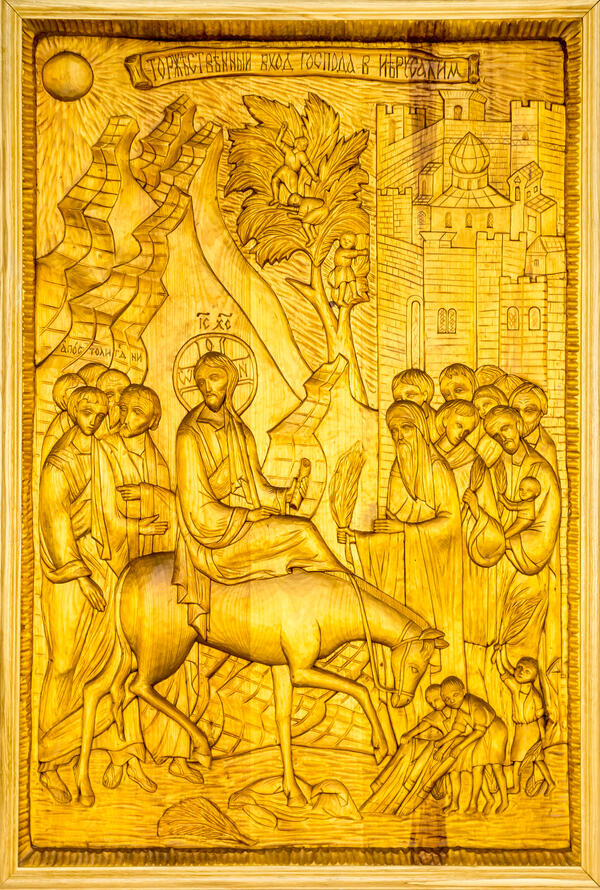The icon “The Entry of the Lord into Jerusalem” tells about the last days of the earthly life of Jesus Christ, when on the eve of the Jewish Passover the Savior rode into Jerusalem on a young donkey. It is believed that this is how the Old Testament prophecy about the King of Israel was fulfilled:
Entry of the Lord into Jerusalem
Время создания
2012
Место создания
Elabuga
Размер
104x70 cm
Техника
wood, carving, varnish
Коллекция
Выставка
#1
Sergey Rozhin
Entry of the Lord into Jerusalem
#4
#5
Rejoice greatly, O Daughter of Zion! Shout in triumph, O Daughter of Jerusalem! See, your King comes to you, righteous and victorious, humble and riding on a donkey, on a colt, the foal of a donkey…
(Zechariah 9: 9)
#2
Painters have long depicted the event according to the well-established iconographic scheme: the Savior rides a donkey, looking at the apostles. His fingers are folded in a two-fingered gesture of blessing. At the entrance to Jerusalem Christ is greeted by crowds of people, who hold palm branches and welcome him with shouts of “Hosanna!” which means “salvation, joy, glory, ” and children lay clothes under the donkey’s feet.
The Lord’s Entry into Jerusalem is celebrated as one of the most important church holidays on the last Sunday before Easter. Since palm branches are an important symbol, this holiday is called Palm Sunday. In the Russian tradition, it is called the Flower-Bearing Week, although it is more often known as Willow Sunday, because in Russia palm branches were replaced by willow ones.
Saint Ambrose, Bishop of Mediolanum interpreted the name of the holiday in the following way,
The Lord’s Entry into Jerusalem is celebrated as one of the most important church holidays on the last Sunday before Easter. Since palm branches are an important symbol, this holiday is called Palm Sunday. In the Russian tradition, it is called the Flower-Bearing Week, although it is more often known as Willow Sunday, because in Russia palm branches were replaced by willow ones.
Saint Ambrose, Bishop of Mediolanum interpreted the name of the holiday in the following way,
#7
It is through the olive tree, from which oil comes, softening wounds and healing diseases, that deeds of mercy are signified; and through a strong date tree, the branches of which are white at the ends, it signifies that after the sorrows of real life we will move to the light of the heavenly homeland.
#6
The icon from the museum collection was created by the artist Sergei Rozhin in 2012. The master performed his first work on a religious theme as an eight-year-old boy — it was a chased image of Jesus Christ.
After finishing school, the author did not receive any art education: at first he mastered the profession of an electric welder, then worked on a fishing boat and served in the fire brigade for ten years. Once a fire broke out in the Intercession Cathedral of Elabuga, and Sergei Rozhin tried to save the carved iconostasis from the fire. At that moment, he did not yet know that after a few years he would be the one to restore it and complete the decoration for the temple.
After some time, the artist took up the work of a designer: he made carved still lifes and panels with Elabuga views. Working with wood, the artist found the work of his life — he began to create icons. Later, he devoted more than ten years to the restoration of the burned-down iconostasis of the Intercession Cathedral, and also created temple shrines for holy relics and carved throne chairs.
In his works, Sergei Rozhin usually uses birch, oak or linden wood. For smaller works, he usually chooses linden wood: this material is easy to work with, it is softly cut in all directions and therefore enables to perform small details.
After finishing school, the author did not receive any art education: at first he mastered the profession of an electric welder, then worked on a fishing boat and served in the fire brigade for ten years. Once a fire broke out in the Intercession Cathedral of Elabuga, and Sergei Rozhin tried to save the carved iconostasis from the fire. At that moment, he did not yet know that after a few years he would be the one to restore it and complete the decoration for the temple.
After some time, the artist took up the work of a designer: he made carved still lifes and panels with Elabuga views. Working with wood, the artist found the work of his life — he began to create icons. Later, he devoted more than ten years to the restoration of the burned-down iconostasis of the Intercession Cathedral, and also created temple shrines for holy relics and carved throne chairs.
In his works, Sergei Rozhin usually uses birch, oak or linden wood. For smaller works, he usually chooses linden wood: this material is easy to work with, it is softly cut in all directions and therefore enables to perform small details.
#3
Ministry of Culture of the Russian Federation
читать дальшескрыть
00:00
00:00
1x
Entry of the Lord into Jerusalem
Время создания
2012
Место создания
Elabuga
Размер
104x70 cm
Техника
wood, carving, varnish
Коллекция
Выставка
Открыть в приложении
Поделиться




